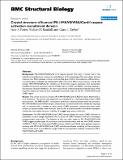Files in this item
Crystal structure of human IPS-1/MAVS/VISA/Cardif caspase activation recruitment domain
Item metadata
| dc.contributor.author | Potter, Jane A. | |
| dc.contributor.author | Randall, Richard Edward | |
| dc.contributor.author | Taylor, Garry L. | |
| dc.date.accessioned | 2010-11-01T15:34:17Z | |
| dc.date.available | 2010-11-01T15:34:17Z | |
| dc.date.issued | 2008-02-28 | |
| dc.identifier | 617509 | |
| dc.identifier | 49862c86-a3da-45ca-9357-72d5db6ecc01 | |
| dc.identifier | 000254711100001 | |
| dc.identifier | 41849132440 | |
| dc.identifier.citation | Potter , J A , Randall , R E & Taylor , G L 2008 , ' Crystal structure of human IPS-1/MAVS/VISA/Cardif caspase activation recruitment domain ' , BMC Structural Biology , vol. 8 , no. 11 , 11 . https://doi.org/10.1186/1472-6807-8-11 | en |
| dc.identifier.issn | 1472-6807 | |
| dc.identifier.other | ORCID: /0000-0002-9304-6678/work/60427031 | |
| dc.identifier.other | ORCID: /0000-0001-9486-566X/work/60428048 | |
| dc.identifier.uri | https://hdl.handle.net/10023/1192 | |
| dc.description.abstract | Background: IPS-1/MAVS/VISA/Cardif is an adaptor protein that plays a crucial role in the induction of interferons in response to viral infection. In the initial stage of the intracellular antiviral response two RNA helicases, retinoic acid inducible gene-I (RIG-I) and melanoma differentiation-association gene 5 (MDA5), are independently able to bind viral RNA in the cytoplasm. The 62 kDa protein IPS-1/MAVS/VISA/Cardif contains an N-terminal caspase activation and recruitment (CARD) domain that associates with the CARD regions of RIG-I and MDA5, ultimately leading to the induction of type I interferons. As a first step towards understanding the molecular basis of this important adaptor protein we have undertaken structural studies of the IPS-1 MAVS/VISA/Cardif CARD region. Results: The crystal structure of human IPS-1/MAVS/VISA/Cardif CARD has been determined to 2.1 angstrom resolution. The protein was expressed and crystallized as a maltose-binding protein (MBP) fusion protein. The MBP and IPS-1 components each form a distinct domain within the structure. IPS-1/MAVS/VISA/Cardif CARD adopts a characteristic six-helix bundle with a Greek-key topology and, in common with a number of other known CARD structures, contains two major polar surfaces on opposite sides of the molecule. One face has a surface-exposed, disordered tryptophan residue that may explain the poor solubility of untagged expression constructs. Conclusion: The IPS-1/MAVS/VISA/Cardif CARD domain adopts the classic CARD fold with an asymmetric surface charge distribution that is typical of CARD domains involved in homotypic protein-protein interactions. The location of the two polar areas on IPS-1/MAVS/VISA/Cardif CARD suggest possible types of associations that this domain makes with the two CARD domains of MDA5 or RIG-I. The N-terminal CARD domains of RIG-I and MDA5 share greatest sequence similarity with IPS-1/MAVS/VISA/Cardif CARD and this has allowed modelling of their structures. These models show a very different charge profile for the equivalent surfaces compared to IPS-1/MAVS/VISA/Cardif CARD. | |
| dc.format.extent | 10 | |
| dc.format.extent | 1030525 | |
| dc.language.iso | eng | |
| dc.relation.ispartof | BMC Structural Biology | en |
| dc.subject | RIG-I | en |
| dc.subject | Antiviral responses | en |
| dc.subject | Adapter protein | en |
| dc.subject | Innate immunity | en |
| dc.subject | RNA helicase | en |
| dc.subject | IKK-epsolin | en |
| dc.subject | Interferon | en |
| dc.subject | Virus | en |
| dc.subject | Model | en |
| dc.subject | Death | en |
| dc.subject | QR355 Virology | en |
| dc.subject.lcc | QR355 | en |
| dc.title | Crystal structure of human IPS-1/MAVS/VISA/Cardif caspase activation recruitment domain | en |
| dc.type | Journal article | en |
| dc.contributor.institution | University of St Andrews. School of Biology | en |
| dc.contributor.institution | University of St Andrews. Biomedical Sciences Research Complex | en |
| dc.identifier.doi | https://doi.org/10.1186/1472-6807-8-11 | |
| dc.description.status | Peer reviewed | en |
| dc.identifier.url | http://www.scopus.com/inward/record.url?scp=41849132440&partnerID=8YFLogxK | en |
This item appears in the following Collection(s)
Items in the St Andrews Research Repository are protected by copyright, with all rights reserved, unless otherwise indicated.

